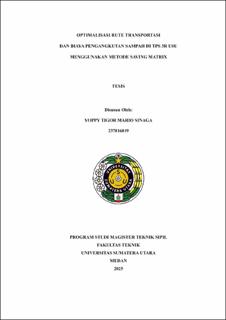Optimalisasi Rute Transportasi dan Biaya Pengangkutan Sampah di TPS 3R USU Menggunakan Metode Saving Matrix
Optimization of Transportation Routes and Waste Transportation Costs at USU's 3R Waste Transfer Station Using the Saving Matrix Method

Date
2025Author
Sinaga, Yoppy Tigor Mario
Advisor(s)
Nasution, Zaid Perdana
Hasibuan, Gina Cynthia Raphita
Metadata
Show full item recordAbstract
The background of the research is based on the increasing volume of waste along with population growth, especially in Medan City, which produces around 2,000 tons of waste per day. The main problem faced is the inefficiency of waste transportation routes, which causes waste of time and money. This research aims to optimize the transportation route and cost of transporting waste at TPS 3R USU using the Saving Matrix method with the help of Machine Learning Python. The Saving Matrix method was chosen due to its ability to minimize mileage, time, and cost by considering vehicle capacity and waste volume. The data used includes coordinates of TPS locations, waste generation, and vehicle capacity, which are then processed using the Python programming language to generate optimal routes. The Nearest Neighbor algorithm was applied to determine the order of the closest visits from the depot (TPS3R USU). The results showed that the route optimization successfully reduced the total mileage and operational costs. The developed Python program produced 12 new routes with an optimal fuel cost of Rp 139.890.503 / year. In addition, this method proved to be flexible and can be applied on a larger scale. The conclusion of this research is that the Saving Matrix method is effective in minimizing the cost and distance of waste transportation. Suggestions for future research include consideration of road dynamics, development of Python programs for additional variables, and evaluation of waste segregation to improve efficiency
Collections
- Master Theses [278]
